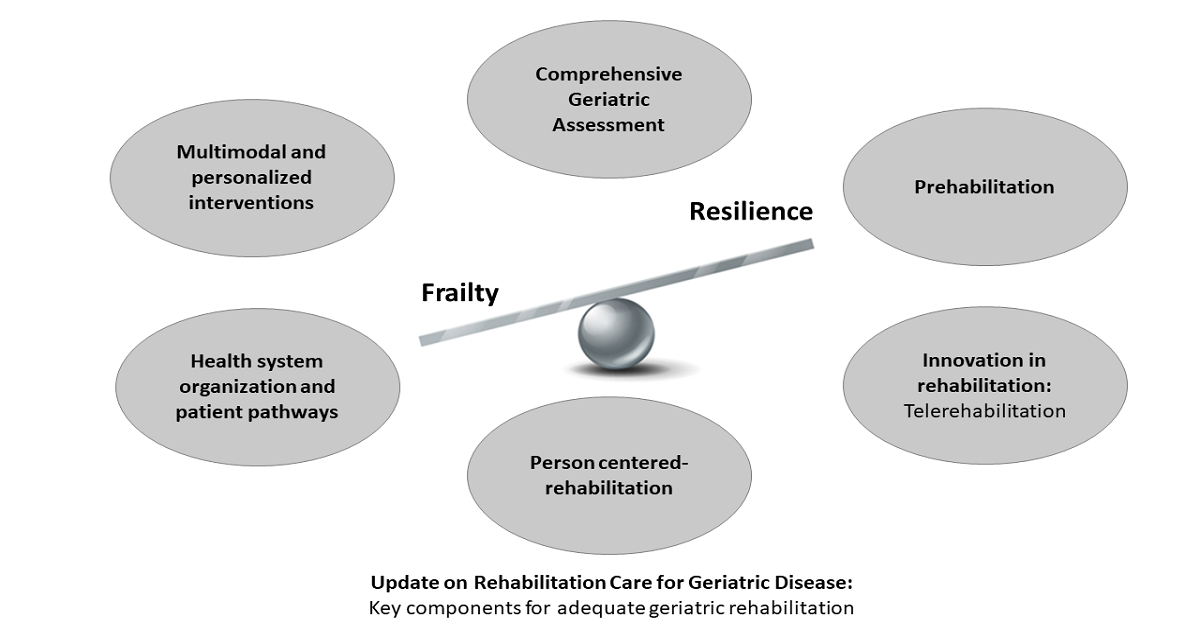- 2.9Impact Factor
- 5.2CiteScore
- 18 daysTime to First Decision
Updates on Rehabilitation Care for Geriatric Disease
This special issue belongs to the section “Clinical Rehabilitation“.
Special Issue Information
Dear Colleagues,
Rehabilitation programmes, in general, include multifactorial interventions to reduce risks, promote healthy behaviours and an active lifestyle, reduce disability, and improve health, wellbeing, daily living activities and social participation. However, in older patients, resilience and frailty can hamper the rehabilitation process. Therefore, the outcomes cannot be easily predicted, even though some factors have previously been associated with rehabilitation effectiveness.
A focus on the resilience of older persons may provide additional sources to induce recovery in an effective way, in turn allowing elderly patients to resume their lives. With an ageing global population, there is a crucial need to optimize the practice and effectiveness of geriatric rehabilitation and make it more sustainable. Additionally, rehabilitation programmes should better address older patient’s goals and wishes.
Telerehabilitation could be an innovative and cost-effective way to achieve this goal. Another aspect of rehabilitation for older persons that needs our attention is the possibility of prehabilitation, which can promote better resilience and rehabilitation effectiveness after elective surgery.
Dr. Guillaume Chapelet
Prof. Dr. Jos M.G.A. Schols
Prof. Dr. Wilco P Achterberg
Guest Editors
Manuscript Submission Information
Manuscripts should be submitted online at www.mdpi.com by registering and logging in to this website. Once you are registered, click here to go to the submission form. Manuscripts can be submitted until the deadline. All submissions that pass pre-check are peer-reviewed. Accepted papers will be published continuously in the journal (as soon as accepted) and will be listed together on the special issue website. Research articles, review articles as well as short communications are invited. For planned papers, a title and short abstract (about 250 words) can be sent to the Editorial Office for assessment.
Submitted manuscripts should not have been published previously, nor be under consideration for publication elsewhere (except conference proceedings papers). All manuscripts are thoroughly refereed through a single-blind peer-review process. A guide for authors and other relevant information for submission of manuscripts is available on the Instructions for Authors page. Journal of Clinical Medicine is an international peer-reviewed open access semimonthly journal published by MDPI.
Please visit the Instructions for Authors page before submitting a manuscript. The Article Processing Charge (APC) for publication in this open access journal is 2600 CHF (Swiss Francs). Submitted papers should be well formatted and use good English. Authors may use MDPI's English editing service prior to publication or during author revisions.
Keywords
- geriatric rehabilitation
- frailty
- resilience
- innovation
- telerehabilitation
- outcomes

Benefits of Publishing in a Special Issue
- Ease of navigation: Grouping papers by topic helps scholars navigate broad scope journals more efficiently.
- Greater discoverability: Special Issues support the reach and impact of scientific research. Articles in Special Issues are more discoverable and cited more frequently.
- Expansion of research network: Special Issues facilitate connections among authors, fostering scientific collaborations.
- External promotion: Articles in Special Issues are often promoted through the journal's social media, increasing their visibility.
- e-Book format: Special Issues with more than 10 articles can be published as dedicated e-books, ensuring wide and rapid dissemination.

